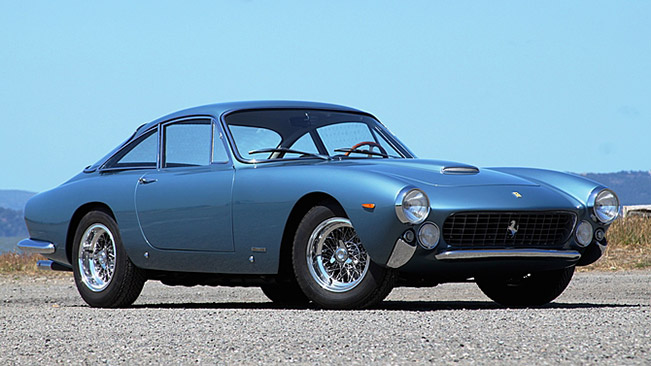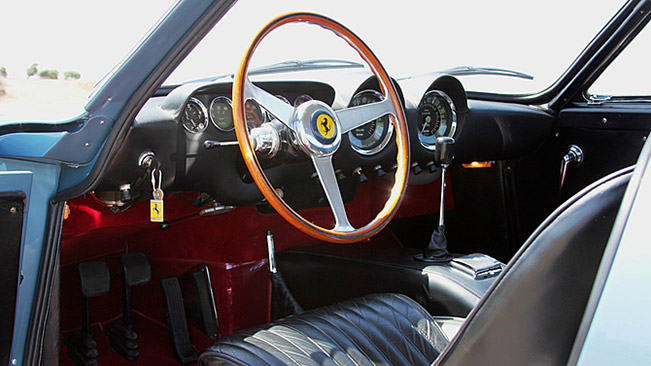 The last and best of the Ferrari 250 road cars, the 250 Lusso is also widely agreed to be among the most beautiful classic Ferraris. While its predecessor, the 250 PF, was restrained and elegant, the Lusso was dynamic and stunning. It was appreciably lower and wider, and the Kamm tail treatment at the rear modernized the aesthetic of the car considerably. Slotted between the larger and more luxurious 250 GTE 2+2 and the competition-oriented SWB, the Lusso split the difference, providing an athletic GT car with arresting visual presence with a comparatively civilized cockpit and driving experience.
The last and best of the Ferrari 250 road cars, the 250 Lusso is also widely agreed to be among the most beautiful classic Ferraris. While its predecessor, the 250 PF, was restrained and elegant, the Lusso was dynamic and stunning. It was appreciably lower and wider, and the Kamm tail treatment at the rear modernized the aesthetic of the car considerably. Slotted between the larger and more luxurious 250 GTE 2+2 and the competition-oriented SWB, the Lusso split the difference, providing an athletic GT car with arresting visual presence with a comparatively civilized cockpit and driving experience.
Under the Pininfarina coachwork was Ferrari’s venerable, and by this time fully developed, 3.0 liter outside plug Colombo V-12 engine, giving the Lusso the classic Ferrari ingredients. Disc brakes were fitted while aluminum deck lids and doors reduced weight somewhat. The interior was trimmed to high standards and featured a unique centrally mounted tachometer and speedometer, which are among the cars signature design elements. Production was relatively brief, from January of 1963 to August of 1964, and just 350 examples were built. Very much the road-going version of Ferrari’s legendary 250 SWB, the Lusso is now a blue-chip collector-quality Ferrari, which, like all classic Ferraris, has enjoyed fantastic appreciation in recent years.
Lusso s/n 5817 is a truly exceptional example, which has always been in California and had a single owner from 1964 to 2005. It was restored to very high standards in its original colors from 2011 to 2014 and comes with an exceptionally complete books set, tools and jack. The car was supplied new by the Ferrari concessionaire in San Francisco, California, Charles Rezzaghi. The car’s first owner was from Los Angeles, and retained the car in the Los Angeles area until 2005. Its second owner kept it two years, also in Southern California, before selling it to its most recent owner (also in Los Angeles) in 2007. He embarked on a comprehensive restoration to the highest standards in 2011, which included a motor rebuild by Allen Bishop and remaining mechanical work by Norbert Hofer’s Gran Touring Classics. Every aspect of the car was restored other than select areas of the interior, which were in excellent original condition and were retained.

Cosmetically, the car has a wonderful presentation that conveys effortless excellence. Rather than being over-restored or excessively glossy, the car has just the right amount of sheen to indicate that it was capably and thoroughly restored, but not overdone. The right parts sparkle, such as the Borrani wire wheels and chrome trim, and the paint was done to high standards but does not look too new or modern. The body is straight with excellent panel fit and operation. The chrome is excellent and the car’s details very nice, including the lovely Marchal headlamps and fog lamps and the earlier-type Michelin XVS tires, rather than the slightly later XWXs often fitted to Lussos.
The interior remains partially original and is excellent overall. The carpets, headliner, and dashboard were redone and are pristine, while other areas did not require restoration. There is a wonderful patina to the seats, door panels, center console, and the quilted rear parcel shelf. The steering wheel, instruments and controls are in excellent shape.
The engine compartment is equally nice, and is thoroughly detailed but not with too much gloss. There are many correct details including the wrinkle finish valve covers, silk-screened air cleaner housing, windscreen washer fluid bag, yellow fuel lines and three-eared airbox keepers. The trunk was also included in the restoration and has new carpets and matching Borrani spare wheel.
Source: www.mecum.com